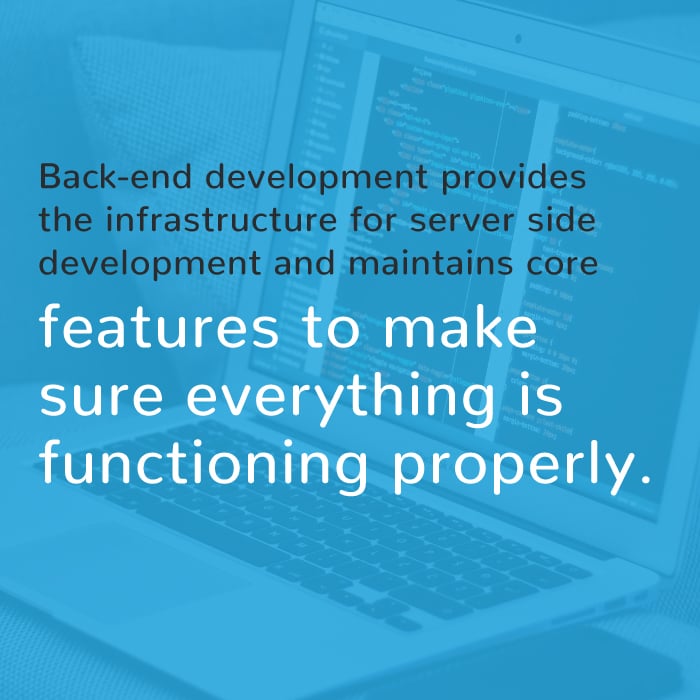There are certain tools and training—such as Slack, code editor, JavaScript, etc.—that all web developers need to know. But, as the web continues to expand and evolve, developers are beginning to specialize, or focus, their career on specific aspects of web development. For example, consider front-end vs. back-end web development. While both front-end and back-end developers are needed and wanted for jobs in the tech industry, both have different roles within a company.
Let’s talk about how a website works before getting into the nitty-gritty of back-end vs. front-end web development.
How a Website Works
Think of your experience when you visit a restaurant. You sit in the dining area and interact with the service staff, or waitstaff. The restaurant might have nice decorations and an overall great atmosphere. You might order something through the waitstaff, with which they go to the kitchen and order your request. While you’re waiting for your food, you don’t see the cooks preparing it, but you know your order is being worked on. When your food is hot and ready, the waitstaff brings it from the kitchen to your table.
Your experience with a website is much like your experience at a restaurant. The front-end aspect of the analogy is everything you see or interact with when at the restaurant. While you’re there, you see the well-decorated dining area and interact with the waitstaff. The back-end part of this analogy is the behind the scenes aspect of the restaurant, or the kitchen. While you can’t see the kitchen, you know your order of food is being fulfilled there.
When you visit a website, there are specific elements to the page that you can see and interact with—images, text, videos, colors, fonts, drop-down menus, sliders, forms, etc. All these things make up the front-end portion of the website. The back-end is everything you can’t see or interact with, such as servers, databases, operating systems, and APIs.
How the Front-End and Back-End Interact
Keep thinking about the restaurant analogy. You give your food order to the waitstaff, they carry it back to the kitchen, put in your order, the cooks prepare your food, and the waitstaff brings you your finished order. Your interactions and experience on a website isn’t much different from that at a restaurant. When you request something on the front end (aka waitstaff), that request is sent to the back end (aka kitchen). The back end fulfills your request (aka food order) and sends the data back to the front end (aka waitstaff). As a result, you have your desired action. It’s a beautiful thing.
Programming for Front-End vs. Back-End Web Development
Both front-end and back-end development require different skills and focuses, or programming languages. While there are hundreds of programming languages for web development, there are specific languages for frontend and backend web development that are more popular and important to know than others.
Front-end developers need to know:
- HTML5
- CSS
- JavaScript
- Ajax
Back-end developers need to know:
- JavaScript
- SQL
- Java
- C#
- Python
- PHP
Careers in Back-End vs. Front-End Web Development
Front-end and back-end developers have different responsibilities within an organization. Because of that, these positions require different skills, responsibilities, and salaries. Here’s a rundown the front-end developer vs. back-end developer positions:
Front-End Web Developer
Description: the front-end web developer (sometimes called a web designer) is focused on the client-facing web-application architecture.
Responsibilities:
- Develop new user-facing features in web browsers
- Design and implement the front end for websites of complex web applications utilizing modern JS and CSS frameworks Build reusable code and libraries for future use
- Optimize front-end applications for maximum speed and scalability
- Code to modern REST or GraphQL best practices
Salary:
Skills:
- Is proficient in HTML, CSS, and JavaScript
- Understands client-side scripting and JavaScript frameworks, such as jQuery
- Understands web-design principles
- Has basic knowledge of graphics editor software, such as Photoshop
Back-End Web Developer
Description: the back-end developer is focused on the server facing web-application architecture.
Responsibilities:
- Design and implement backend web architecture, such as servers, databases, operating systems, and APIs
- Integrate user-facing elements with server-side logic
- Build reusable code and libraries for future use
- Optimize backend applications for maximum speed and scalability
- Implement data security solutions
Salary:
- $56,000 – $128,000 per year; $88,488 average (the most recent information Glassdoor has for back-end web developer salary is from 2016)
Skills
- Is proficient in languages such as JavaScript (NodeJS), Ruby, Java, SQL, and C#
- Has working knowledge of PHP, Ruby, Python, and .Net
- Has working knowledge of server-side CSS preprocessors, such as LESS and SASS
- Understands accessibility and security compliance
- Is capable of authenticating and authorizing between systems and servers
- Is capable of integrating multiple data sources into a single system
- Is capable of host-environment management
- Understands how to scale applications
- Understands data migration, scripting, and transformation
- Is able to set up and maintain backups
- Understands versioning and business logic
- Understands session management
If you’re interested in both front-end and back-end development, consider a career in full-stack development. A full-stack developers can work with both front-end and back-end web development responsibilities.
What All This Means
So, why is it important to know front end vs back end web development before deciding if you want to start a career in web development? The web has evolved, and continues to evolve, into a commodity that every business must have. Figure out whether you see yourself at the front end of the website or the back end. Once you have decided which fits you best, there are many web-development education opportunities available to you, including coding bootcamps. Devmountain has many different class options available; check out our course listing, and whether you’re interested in back-end or front-end web development, we offer the education you need to make it happen.
[cta id=”589″ vid=”0″]










